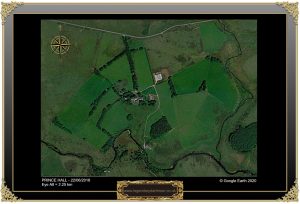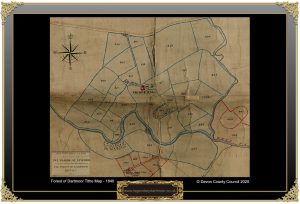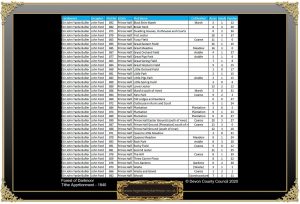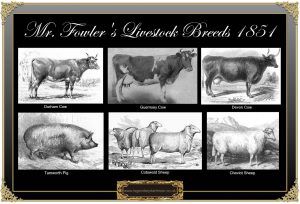
During the 1800s some landowners were of the belief that Dartmoor could produce lucrative crops and began an era of ‘improving’ the land. One of the early pioneers of this idea was Sir Thomas Tyrwhitt who advocated the growing of flax on his Tor Royal estate. Another such man was G. W. Fowler who took over the Princehall estate in 1847 which previously had been farmed in the ‘traditional’ Dartmoor way. As can be seen from the tithe map and apportionment below it was not a massive estate and consisted of around 250 acres. Most of the was meadow, course pasture, woodland with a small amount of arable land. In the October of 1851 an agricultural journalist was given a conducted tour of the ‘improved’ Princehall estate by Mr. G. W Fowler and it makes for some interesting reading:
“Princehall is an enclosure of 400 acres, about 150 of which are at present in a state of high cultivation. The estate was originally taken in from the moor in 1805, and had been farmed in a very rude manner up to the spring of 1847, when Mr. Fowler, who had just retired from commercial life in Liverpool, became its purchaser on easy terms. He at once set about improving it by draining, sub-soil ploughing, manuring and liming. The natural soil, which is very dark, is of a light peaty character, but by deep ploughing, a heavier sub-stratum is brought up, and mixed with the surface soil, thereby increasing its weight, and greatly adding to its fertility.
The altitude of the estate is about 1,100 ft. above sea level, which renders it ill-adapted for the production of grain crops; but the heavy dews and frequent showers, arising from the mountainous character of the country, cause it to be admirably adapted for the growth of green crops and grass, which have been produced of heavy weight and most luxuriant character. Mr. Fowler has long enjoyed a high reputation for the growth of turnips, and obtained prizes for them at some of the agricultural exhibits in Devonshire. The greatest weight which he has grown of Swedish turnips per acre, as examined and weighed by the judges of the South Devon Agricultural Association, was 35 tons per acre, with the tops and bottoms cut off. Another crop of white turnips, grown on the same estate, was weighed by the judges of the Tavistock Agricultural Society, with the bottoms taken off but the tops remaining, and found to amount to 44 tons per acre. The field in which this crop was grown has been most thoroughly drained, many of the drains being from three to four feet deep, and all made of stone, of which there was an abundance on the spot. The principal drain in the field is about eleven feet deep, and we were told that the apertures of the other drains were about 9 inches square. The same field is now in grass, and for the last four months has been keeping, during the day only, two milch cows per acre, and we observed that the grass is now very thick and luxuriant.. Mr. Fowler told us that this field, prior to its cultivation, was all but worthless, producing only rushes and other kinds of aquatic plants and being covered with masses of granite rock. It is now perfectly dry, and cleared of the stone, which has been rendered useful in the erection of high and substantial fences, of which description of fencing Mr. Fowler has built no less than seven miles since he obtained possession of the estate.
The outbuildings of the farm next attracted our attention: and it appears that they were originally designed upon the new principle of box-feeding. Seventy distinct pit or boxes were made, each 9 feet square and 17 inches deep; but Mr. Fowler says he soon discovered the disadvantages of this system, as it was found to require a very great quantity of straw – a scarce article on this farm – to keep the cattle dry, and a considerable number of these boxes have now been filled up, the cattle standing in the usual way, on the level with a slight incline. We were much struck by an ingenious method adopted in these buildings for saving the liquid manure, that portion of the stall upon which the hind part of the animal stands being composed of bars made of oak, about 4 inches square, 4 feet 6 inches long, and placed at a distance of 2 inches apart. A steep incline underneath the open bars carries all the liquid manure into a covered dung pit capable of holding several hundred of loads; and the proprietor estimates this manure to be much more valuable than that which is exposed to the actions of the atmospheric air, and the washing of the rain. It is worthy of remark, that nearly all the root crops which have been raised on this estate, amounting to about 600 tons a year, and which are celebrated throughout Devonshire for their quality and size, have been produced almost entirely by the manure generated in the cattle building of which I have been speaking; and in which I observed 20 milch cows in fine fine condition.
The out buildings for housing cattle, consist of four large compartments under distinct roofs, with another roof covering the dung pit, which runs at right angles. In each compartment there is a tramway, which passes across a narrow road, dividing the root houses from the cattle buildings, and on which the necessary food is conveyed into them at a great saving of time and labour. In one division of the building, which has a easterly aspect, an arrangement is made for the reception of sheep in the winter, and ewes during the early part of the lambing season, when it is desirable to protect them from the inclemency of the weather. The sheep stand on bars of oak, an inch and a half square, placed at distances of an inch apart and underneath there is a space about 17 inches deep, fro 6 to 8 inches of which is covered with peat charcoal and peat ashes, or some similar substance, upon which are received the droppings from the sheep, which are stirred about once a month, and at the end of 3 months the manure is taken out, and either used in April on spring grain, or with turnips when sown. This year it was mixed with two hundredweight of salt per acre, and sown upon oats, the results proving most satisfactory.
With reference to the description of the cattle which the proprietor finds best suited to his farm, he told us that he had tried Durhams (today known as Shorthorns), and found that they possessed a great aptitude to fatten, but did not produce a large quantity of milk; he had therefore entirely abandoned them, and now limited his milch cows to Devons and Guernseys.
We were next shown the pigs, most of which are of the pure Tamworth breed, and remarkably fine, one of them being estimated at upwards of 40 scores. Mr. Fowler informed us that he had incurred great expense in experiments upon various kinds of pigs, with a view to ascertain which possessed the greatest aptitude to fatten, and the results satisfied him of the great superiority of the Tamworth breed.
We were then conducted to the engine house, where we found an engine of four horsepower, which works a threshing machine, a winnowing machine, &c; and we were told that the day before eight quarters and a half of oats was threshed and winnowed in about two hours, the engine being fed with peat fuel cut from the moor. Part of the oats were also bruised by the same power, Mr. Fowler adopting this practice with all the oats consumed on his premises. We saw grain, and have seldom observed a finer sample in Market Lane. Leaving the buildings we proceeded to some grazing fields, in one of which the proprietor pointed out to us a flock of breeding ewes, some of which he appeared to set a very high value upon; and we attained from him that these were, in his opinion, the only breed of the kind in the kingdom, being the production of a cross between one of the celebrated Charles Larges’Cotswold rams, and some picked Cheviot ewes. As far as we could judge, they appeared most symmetrical, and we were told they had received the highest encomiums of some distinguished agriculturalists. A flock of lambs was next pointed out to us, which appeared nearly as large as old sheep. There were also amongst the breeding ewes a few of the original Dartmoor ewes; but although they were considered very good of the kind, they certainly appeared inferior to the new breed: and we were told that both had fared and been exposed in the same way. Mr. Fowler thinks his new breed will prove a very valuable one, and decidedly superior in its fattening qualities to the original Dartmoor; but on account of its cutting on an average about three or four pounds per fleece less in weight, most of the moor farmers adhere to the old breed preferring a heavy fleece, although with a lean light carcass. It should be stated, however, that Mr. Fowler gets two pence per pound more for the wool of his cross-breed sheep than can be obtained for that of the Dartmoors, the former being of a finer quality. The heaviest Dartmoor fleece, it appears, weighs from 9 to 10 pounds, whilst that of the mixed breed averages from 6 to 7 pounds.
The timber planted by Justice Buller on this estate consists chiefly of common firs and beech, which appear to have grown well, and now forms groups of woodland that pleasingly relieve the monotony of this otherwise tree-less region. The present proprietor planted 60,000 trees, all of which are carefully fenced, and consisting chiefly of the Austrian pine, spruce, fir, beech, oak, chestnut, ash, &c.
Passing through the gardens which adjoin the house – a well-built and commodious mansion – the “gloaming of the day,” as the Scottish poetically term it, warned us of the necessity of hastening our steps, and we proceeded rapidly to view in the dim twilight a substantial and well-contrived building, which had been erected, with the moorland stone, to provide shelter for the sheep and cattle during the most inclement periods of the winter season. It comprises of a large semi-circular enclosure, paved with granite, and surrounded by a high wall, within which are erected sheds in which the cattle can take shelter at night, and during the storms of rain and snow. The necessity of such a building has been admitted by all agriculturalists, who have seen it, and its advantages are acknowledged to be great.” – The Daily News, October 9th, 1851.
Many of the features of this farm can be seen on modern farms today, albeit they have been modernised and mechanised. Virtually every dairy farm will have its slurry pit/lagoon with similar methods of transporting the slurry into them. Looking back it appears that Fowlers’ improved breed of sheep never took off as shortly afterwards the Scotch Blackface sheep breed became the one of choice. Oddly enough these were reported to be introduced by a Mr. Lamb who succeeded Fowler at Princehall. There can be no argument that Mr. Fowler improved the land as suggested above. A hint of the previous poor condition can be found in the names of the enclosures on the 1840 tithe apportionment – the name ‘Break Neck’ is indicative of land that was hard to work, then you have ‘Furzy Field’, ‘Rock Park’, Rocky Field’ and several fields described as being ‘course’ all of which suggest unproductive land.
It’s also interesting to note the subject of fleece values, according to the above he was getting two pence more for his fleeces. Unfortunately there is no mention of the total value but in 1851 according to the inflation calculator two pence was worth the today’s equivalent of 58p. The British Wool Index for February 2020 was £1.29 a kilo and the 1851 comparison runs out at £1.16p per kilo. Therefore just taking the extra value Fowler was getting for his fleeces shows how much the value of wool has dropped today, incidentally if a farmer hires a shearer he will be charged around £2 a sheep!
 Legendary Dartmoor The many aspects past and present of Dartmoor
Legendary Dartmoor The many aspects past and present of Dartmoor





Really pleased to have another (unexpected) Digest. Perhaps because I thought it had gone I took much more interest in opening several pieces. I’ve found them fascinating, entertaining and informative. I hope you decide to reinstate your Digest. Much appreciated.